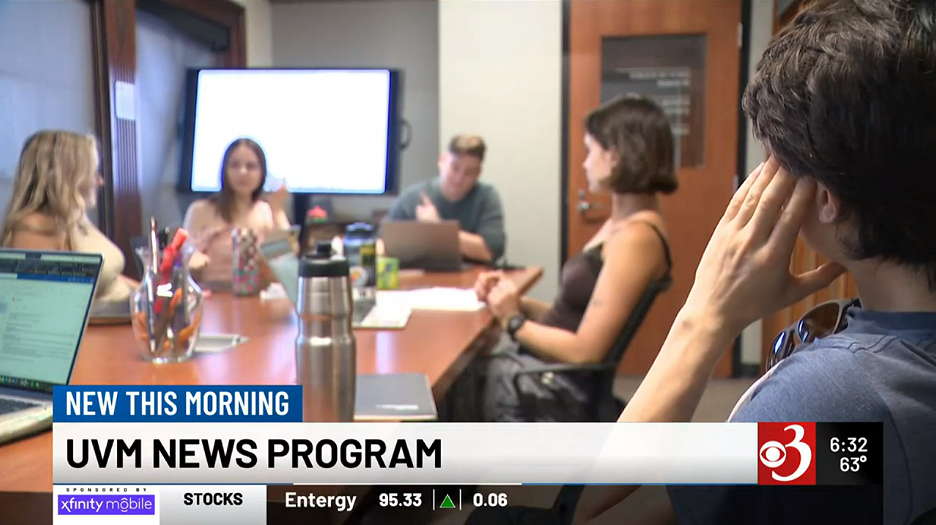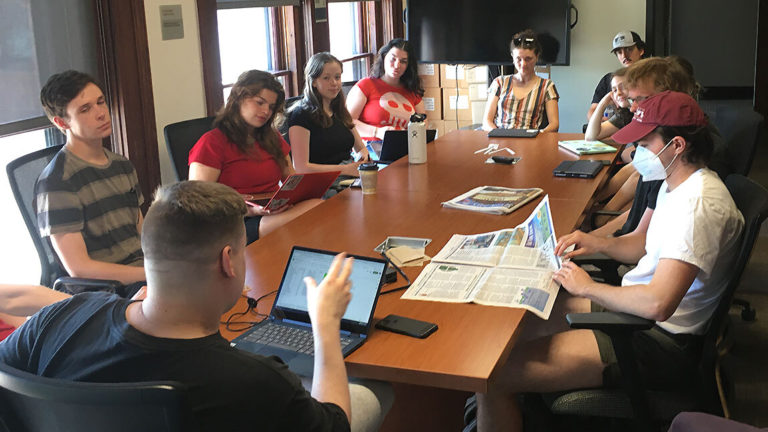By Greta Solsaa
The Community News Service (CNS) was founded in 2019 with the expressed intent to foster a thriving community news landscape in Vermont.
CNS began as an offshoot of the community of practice internships the University of Vermont’s College of Arts and Science offered to students who were looking to gain more meaningful experience that was managed by professionals in the field, according to Richard Watts–senior lecturer in the department of Geography, director of the Center for Research on Vermont, director of the Center for Community News, and most relevantly the coordinator of the Community News Service.
Watts saw an opportunity to expand on this effort of the University of Vermont to develop a journalism internship program called the Community News Service that connected students to local outlets around the state.
“I really feel like we in academia could do so much more to engage our students in doing actual work,” said Watts. “It contributes to the community, but first and foremost, our mission is to do good for our students.”
The Community News Service has grown exponentially over the past few years. In 2023, the program is projected to produce 289 pieces of journalism, including mostly written articles but also some photography and audio media.
“At its core, what CNS does is give students the opportunity to report and write articles for news outlets and newspapers and stations,” said Justin Trombly, the managing editor for the Community News Service. “We traditionally would pair students directly with a specific outlet. We have expanded to include statewide reporters who function as a wire service.”
The CNS program is a credit-bearing internship that consists of several cohorts of students. The entry level of the CNS program are courses taught by Carolyn Shapiro, a freelance journalist for Seven Days and a myriad of other publications. In this class, students learn about journalism theory while also practicing in the field by writing stories on assignment for local outlets.
“[The students] are telling stories that readers aren't necessarily getting somewhere else and that they're contributing to both vital information and quality of life for people,” said Shapiro.
The advanced group of CNS statewide reporters cover specific beats such as environmental issues and legislative concerns. CNS has partnered students directly with around twenty local papers around the state, and statewide outlets such as VTDigger and Vermont Public have picked up stories penned by student journalists with CNS such as an investigative piece on the state’s failure to provide Vermont farmers with flood relief funding.
 “So everything produced by CNS is published through our website and made available to anyone who wants to republish it. They don't even need to be a direct partner with our program. We operate just like many nonprofit news outlets in that regard,” said Trombly.
“So everything produced by CNS is published through our website and made available to anyone who wants to republish it. They don't even need to be a direct partner with our program. We operate just like many nonprofit news outlets in that regard,” said Trombly.
Along with uploading stories to the website, thes student-reported stories are promoted directly through emails and newsletters to editors around the state.
This fall, CNS launched a redesigned website as well. One of the major benefits of this change was that CNS can now track the amount of times stories are viewed and published. When news outlets use the republish button on the website and the HTML version of the article, it includes a pixel tracker technology which offers data insights on CNS's impact on an empirical level.
Shapiro emphasized that while CNS needs proper metrics for its reach, the success of the program is tied to the success of local news.
“[CNS] stories have a lot of legs, and they get wide ranging exposure. We have yet to really promote our site as a news source because our role is to serve those who want to drive the traffic to community papers,” said Shapiro.
The program was conceived as a means to support local news outlets that have limited staff and capacity for community reporting, so a bulk of Trombly and Shapiro’s role with CNS is editing. Trombly and Shapiro believe students can learn to be better writers through the revision process, so they meet with every student to edit before sending stories for publication.
“We fully edit to publication standards for the partners,” said Shapiro. “We want both our students and the community partners—the news outlets—to have really top quality work to show for the effort.”
The existence of CNS is particularly remarkable because there is no journalism program at the University of Vermont. There is an interdisciplinary reporting and documentary storytelling minor, and some reporting classes, but no major or school of journalism at the university.
Therefore, students involved with the CNS have a variety of academic backgrounds and writing abilities, and are not often intending to become journalists professionally. However, Shapiro said that she doesn't mind when students try out reporting through the CNS program and move on.
“Even if they don't go on to stay in journalism, they're becoming smarter citizens. They're becoming more media literate,” said Shapiro. “They're going to be successful in any field they go into because of these skills.”
CNS has graduated their first working journalists despite not having a formal journalism department at UVM and more students have begun considering journalism as a potential career path due to their experience in the program, said Trombly.
This is hopefully just the beginning. “I think we will see more people who show up at UVM interested in [journalism] as a career and then pursue it. We're building something really strong here that's fairly unique among news academic partnerships, so maybe there's a future where people come to UVM for CNS,” said Trombly.
Shapiro hopes that as CNS grows, the program will have more resources such as the updated Associated Press Stylebook, a library of all the community partners’ publications students can see their work in print, and transportation funds so student journalists don’t have to rely on so heavily remote reporting.
This August, the University of Vermont hired Trombly as full-time staff and have begun to allocate some funds for the program. But, the CNS program continues to operate with limited funds and infrastructure at UVM and relies on incremental, external funding, according to Richard Watts.
The success of the Community News Service inspired the birth of the Center for Community News, which serves to research and support news-academic partnerships like CNS around the country.
“As we were looking around the country, it was really interesting to see these people were doing that there and these people were doing it there, but nobody was helping them connect,” said Watt
 CNS shares open offices with the Center for Community News and the Center for Research on Vermont, and the space serves as a working newsroom for students in the program. Along with working with students through every step of the journalism process, Shapiro and Trombly host movie nights and election night workshops with pizza to cultivate a sense of community.
CNS shares open offices with the Center for Community News and the Center for Research on Vermont, and the space serves as a working newsroom for students in the program. Along with working with students through every step of the journalism process, Shapiro and Trombly host movie nights and election night workshops with pizza to cultivate a sense of community.
“We treat them as working journalists. We treat our program as a working newsroom,” said Shapiro. “There's not a newsroom that I haven't worked in on election night that doesn't get pizza for its staff who are working very, very hard to get that vital information out to people, and so we do the same thing.”
The working newsroom Trombly and Shapiro have created through the CNS program is mutually beneficial for students and local news in Vermont, according to Trombly.
“Fundamentally, our news-academic partnership is a win-win,” explained Trombly. “Papers get free content. It's edited to a professional standard by Carolyn and I, and students, along with getting published, get to have those intimate workshopping sessions on each and every story that they do, so they really get to learn hands-on while also providing a service to outlets around the state.”

